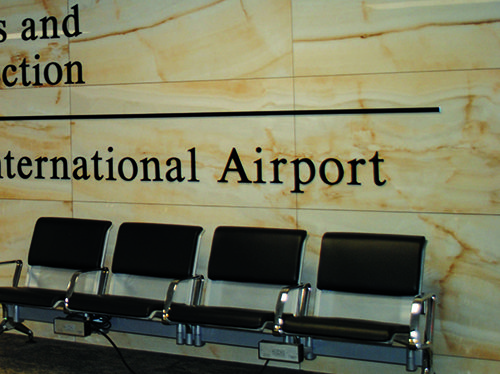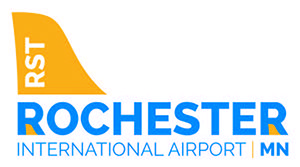In addition to serving local travelers, Rochester International Airport (RST) caters to thousands of passengers who fly to southern Minnesota each year for care or work at the world-renowned Mayo Clinic. In fact, the two organizations, located just 15 minutes apart, are inextricably linked.
In addition to serving local travelers, Rochester International Airport (RST) caters to thousands of passengers who fly to southern Minnesota each year for care or work at the world-renowned Mayo Clinic. In fact, the two organizations, located just 15 minutes apart, are inextricably linked.
 The Mayo brothers, William and Charles, built the first airport in Rochester in 1928; and ties to their early efforts are now evident at RST. The city-owned facility is operated by the Rochester Airport Company, a wholly owned subsidiary of Mayo Clinic.
The Mayo brothers, William and Charles, built the first airport in Rochester in 1928; and ties to their early efforts are now evident at RST. The city-owned facility is operated by the Rochester Airport Company, a wholly owned subsidiary of Mayo Clinic.
Last summer, RST completed a $12.3 million project to modernize its terminal and improve its U.S. Customs & Border Protection facilities—upgrades that will greatly benefit passengers and garnered RST several awards, including Commercial Service Project of the year from the Minnesota Council of Airports.
|
Project: Upgrades to Terminal & U.S. Customs & Border Protection Facility Location: Rochester (MN) Int’l Airport Operated by: Rochester Airport Co. (wholly owned subsidiary of Mayo Clinic) 2018 Passenger Volume: 370,000 Passenger Airlines: American; Delta; United Project Cost: $12.3 million Funding: FAA -$7.35 million; state of MN- $3.12 million; city of Rochester-$1.83 million Timeline: April 2017-Aug. 2018 Architect/Engineer: Mead & Hunt Inc. Contractor: Kraus-Anderson Construction Co. New Federal Inspection Station: 20,000 sq. ft. Medical Cargo: 22 million pounds/year, via FedEx Express Project Awards: 2019 Project of the Year—MN of Council of Airports; Kraus-Anderson Construction Co.—MN Construction Assoc. Merit Award; Top Project of 2018 – Finance & Commerce |
Recent improvements will also help the airport keep pace with continued growth. Last year alone, passenger traffic increased 28% to 370,0000, notes Executive Director John Reed. Beyond providing passenger service on three major airlines, RST handled 22 million pounds of medical cargo such as specimens and supplies via FedEx Express.
The recent modernization project, led by architects at Mead & Hunt, broke ground in April 2017; and the airport celebrated the grand reopening of its updated terminal in August 2018.
Project Overview
“The project certainly was a long time coming,” says Matt Dubbe, national market leader of Architecture for Mead & Hunt.
Before beginning the design process, the team took stock of the extended list of project stakeholders, which included TSA, Homeland Security, Mayo Clinic, the city of Rochester and multiple airlines. “We had to prepare for a lot of review time,” Dubbe notes.
“We were in every little corner of this airport doing something,” adds Chad Pike, project manager for construction contractor Kraus-Anderson. He notes that upgrading the U.S. Customs and Border Protection facility was a significant project in its own right, given the airport’s growth in international passenger volume.
In 2015, there was a push from the federal government to upgrade RST’s Customs facility. It was simply too small and needed greater capacity to clear the amount of people coming from around the world to do business in Minnesota or visit Mayo Clinic, explains Reed.
 “The existing facility was down in our FBO, with less than 500 feet of space; and yet we were clearing 747s, 757s, Airbuses, even 787s,” he recalls.
“The existing facility was down in our FBO, with less than 500 feet of space; and yet we were clearing 747s, 757s, Airbuses, even 787s,” he recalls.
To address RST’s particular needs, the design team developed a new type of Federal Inspection Station (FIS) that expands the functionality of the main terminal and provides use of a jet bridge to domestic commercial operations when it is not in use by Customs for wide- and narrow-body aircraft. The team had to demonstrate the design’s efficacy and security to the Department of Homeland Security before it could be built, notes Dubbe. Now, RST is the first airport in the country to have a hybrid FIS. “We also wanted to make sure the airport was positioned to process larger international charter aircraft in the future,” he adds.
The new FIS is four times larger than the previous Customs facility. With 20,000 square feet of space, it is large enough to hold 150 people and equipped to process 75 passengers per hour. More than 200 aircraft and approximately 1,200 passengers travel through the RST Customs facility each year.
The airport gained additional space for the new FIS by redesigning the main terminal, which was originally a mirror design with ticketing and baggage on both sides. Today, all ticketing counters are in one area and baggage is in another.
 For about half of the active construction period, only one baggage claim was open. “It was a critical phase for us and the airport,” Pike recalls. After the additional baggage claims were reopened, the focus shifted to remodeling the passenger screening area.
For about half of the active construction period, only one baggage claim was open. “It was a critical phase for us and the airport,” Pike recalls. After the additional baggage claims were reopened, the focus shifted to remodeling the passenger screening area.
The airport’s previous TSA checkpoint was well out of standard, notes Reed. During the modernization project, designers expanded the area and made it more user-friendly. They also added additional restrooms just beyond the checkpoint.
“The unsung part of this project was bringing the building up to code,” Reed reflects. “We spent a lot of time upgrading some of the base systems: sprinklers, fire alarms, heating and a generator in the Customs facility.”
Pike says the overall design by Mead & Hunt has received a lot of positive feedback, and he enjoyed helping it come to life. He reports that federal personnel who have visited to assess the changes were succinct in their comments: “We should make this a model for the rest of the country.”

Caring Design Details
The airport’s new terminal includes three quiet rooms, specially designed for passengers who are ill or particularly stressed by medical challenges. One is located in the main lobby, and two are post-security. Each is equipped with a private restroom and a bed or recliner. Airline and airport personnel are trained to spot patients who may need respite and direct them to one of the rooms.
To cultivate a positive atmosphere for passengers throughout the terminal, designers integrated more daylight—even in stairwells. Marble walls were simulated with porcelain tiles to provide a soothing environment.
 As a Rochester-based company, Kraus-Anderson had previous experience on many projects with patient care implications. “It’s always interesting and intriguing,” says Nick Leimer, director of operations for the construction contractor. “There are all different kinds of people coming through this airport; so when you start to think about the components to have in place to accommodate them, it can really have an impact on our community for many years.”
As a Rochester-based company, Kraus-Anderson had previous experience on many projects with patient care implications. “It’s always interesting and intriguing,” says Nick Leimer, director of operations for the construction contractor. “There are all different kinds of people coming through this airport; so when you start to think about the components to have in place to accommodate them, it can really have an impact on our community for many years.”
In addition to being forward-thinking, the special design considerations help demonstrate RST’s firm and long-term commitment to serving the patients, visitors and staff of Mayo Clinic, adds Dubbe.
Challenges & Successes
Maintaining operations during construction was cited as the biggest challenge of the modernization project.
United joined the airport’s carrier lineup in June 2017, just a few months after construction was underway. In addition, Delta increased its flight frequencies and American increased the size of aircraft it flies into and out of RST. The cumulative result: more passengers, which meant more activity in the terminal.
“During this entire project, we were seeing double-digit growth, month over month,” notes Tiana M. O’Connor, marketing and communications manager for the Rochester Airport Company. “The challenge was to put that many more people through a facility that was already constrained with temporary walls and construction going on. But everyone really stepped up and did a great job.”
 Moving the sophisticated TSA scanning equipment and keeping lines open amid construction was not simple, recalls Pike. “It wasn’t like we were able to shut down one checkpoint and use another for two days,” he comments. “Everybody had to get along and get cozy!”
Moving the sophisticated TSA scanning equipment and keeping lines open amid construction was not simple, recalls Pike. “It wasn’t like we were able to shut down one checkpoint and use another for two days,” he comments. “Everybody had to get along and get cozy!”
In a similar vein, crews didn’t have the luxury of bringing concrete trucks into a separate staging area; they had to come into the space where daily airport operations were occurring. “This terminal isn’t huge in scale, like O’Hare,” says Leimer. “So we couldn’t phase the construction to occur when people aren’t around.”
Good communication was key to keeping the workflow smooth and disruptions to a minimum, he emphasizes.
“We really had to understand that they had a business to run,” Pike adds.
Dubbe commends the airport on fulfilling a long-term vision that spanned leadership transitions and still came in under-budget.
In turn, Reed gives a nod of appreciation to Mead & Hunt and Kraus-Anderson for their knowledge and dedication to completing a unique and demanding project. He also credits the FFA, city and state for understanding what the airport was trying to accomplish. “The project was recognized at the legislative level to be of marquee value to the state, as Mayo Clinic is the largest employer in Minnesota,” he explains.

The Next Chapter
As major tech and biomedical companies move parts of their businesses to Rochester for proximity to Mayo Clinic, the buzz and increased activity at RST is noticeable. Every day, the effects ripple through TSA, the airlines, car rental companies and even the parking lot, which is starting to become strained on a regular basis, Reed reports.
“It’s been very rewarding professionally to be a part of this,” he reflects. “And this is just the beginning. We now have 100 companies within our community that have pledged to fly local, but also put into their policies and practices to make RST their airport of choice.”
The shift began five years ago, with the launch of the Destination Medical Center, which is executing a 20-year, $5.6 billion economic development initiative supported by the state of Minnesota, Olmsted County, city of Rochester and Mayo Clinic.
 Lisa Clarke, the agency’s executive director, explains that half of the initiative is focused on Mayo Clinic, while the other half concentrates on attracting private investment from around the globe. “We will be bringing about 30,000 jobs in the next 20 years and generating billions of dollars in new tax revenue; but the premise of Destination Medical Center is to create quality patient, companion, visitor, employee and resident experiences.”
Lisa Clarke, the agency’s executive director, explains that half of the initiative is focused on Mayo Clinic, while the other half concentrates on attracting private investment from around the globe. “We will be bringing about 30,000 jobs in the next 20 years and generating billions of dollars in new tax revenue; but the premise of Destination Medical Center is to create quality patient, companion, visitor, employee and resident experiences.”
Where does RST fit in? Clarke says that transportation is the backbone that’s critical to the success of the initiative and the city as a whole.
“We are very happy to have an international airport in Rochester supporting our patients, but also the talent and growth we need to drive to here,” she says. “They are definitely a forward-thinking organization, and the airport is really supportive of the economic development of the city.”
As the Rochester area continues to grow and change, the airport will continue developing with it. Next on RST’s list is $52 million airfield project to rebuild Runway 2-20 and finish the airport’s CAT II Instrument Landing System.



 facts&figures
facts&figures

